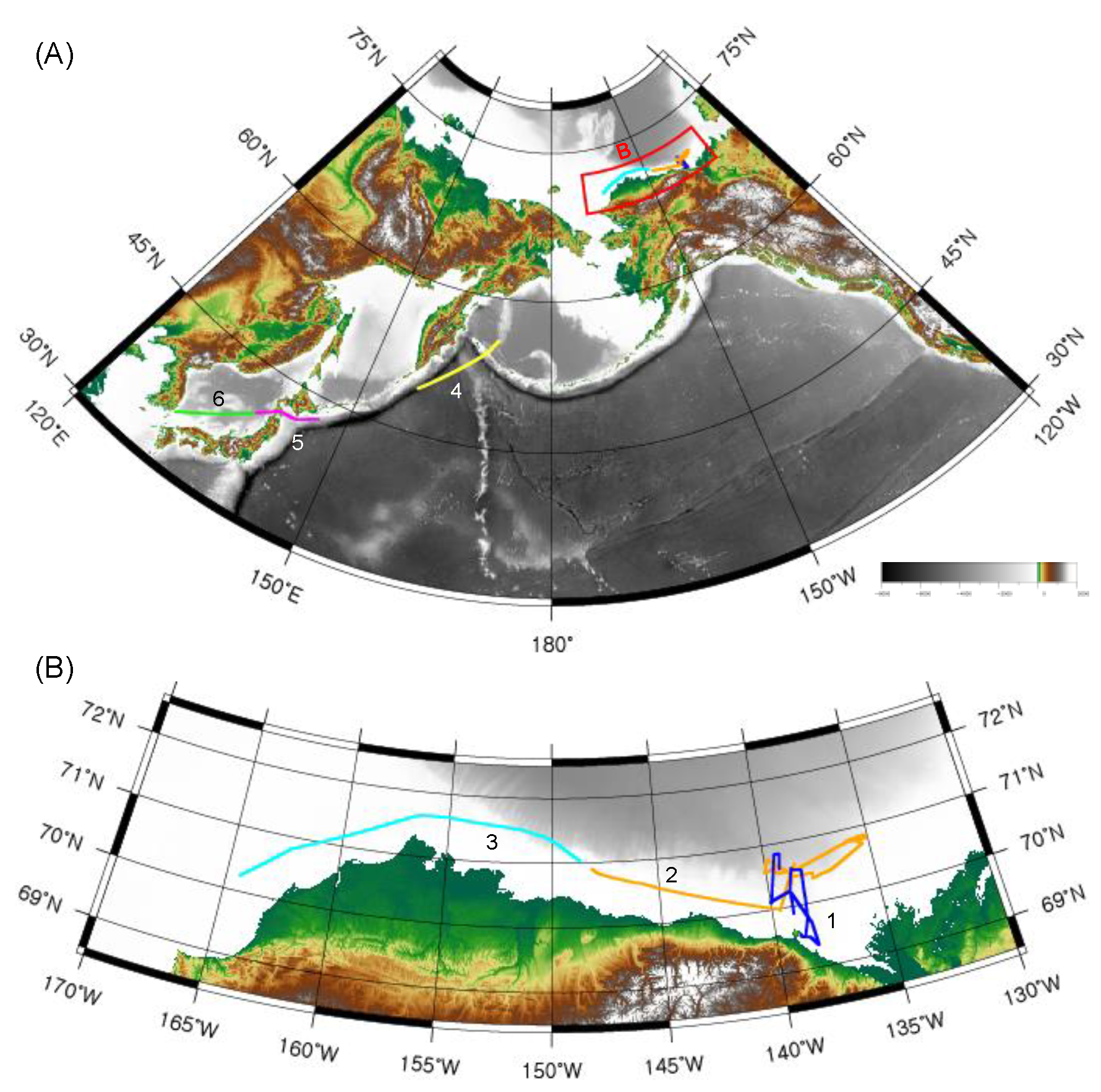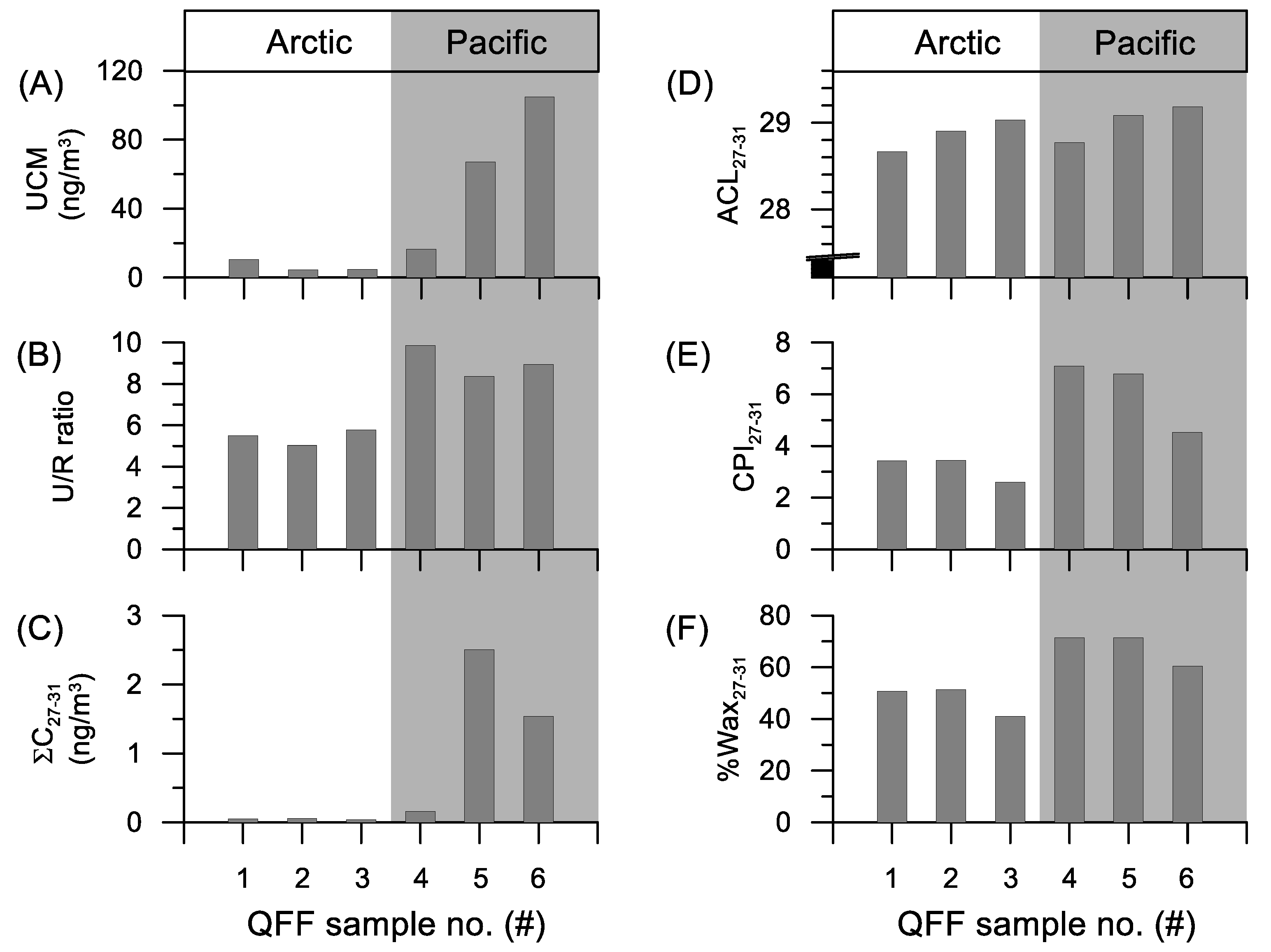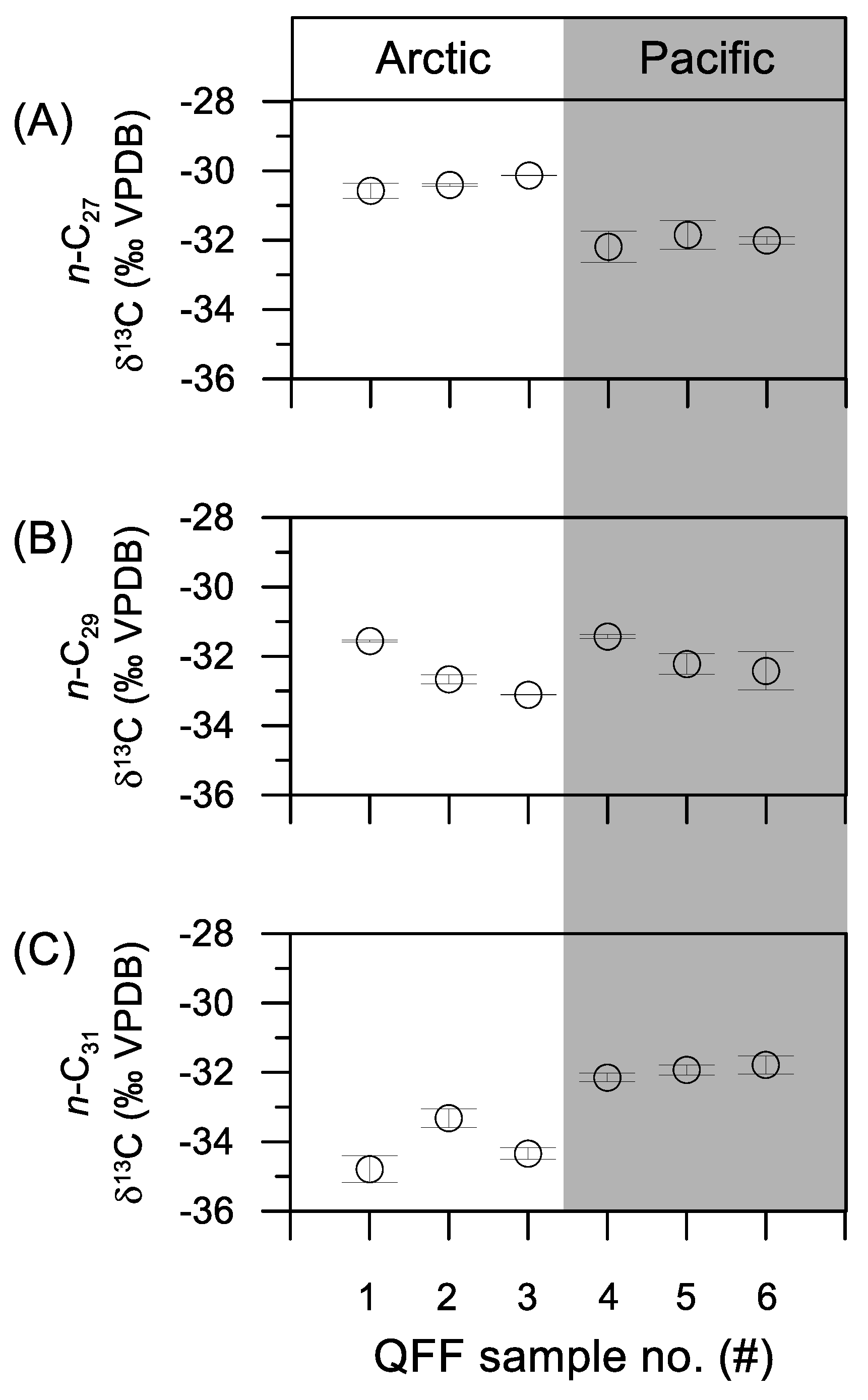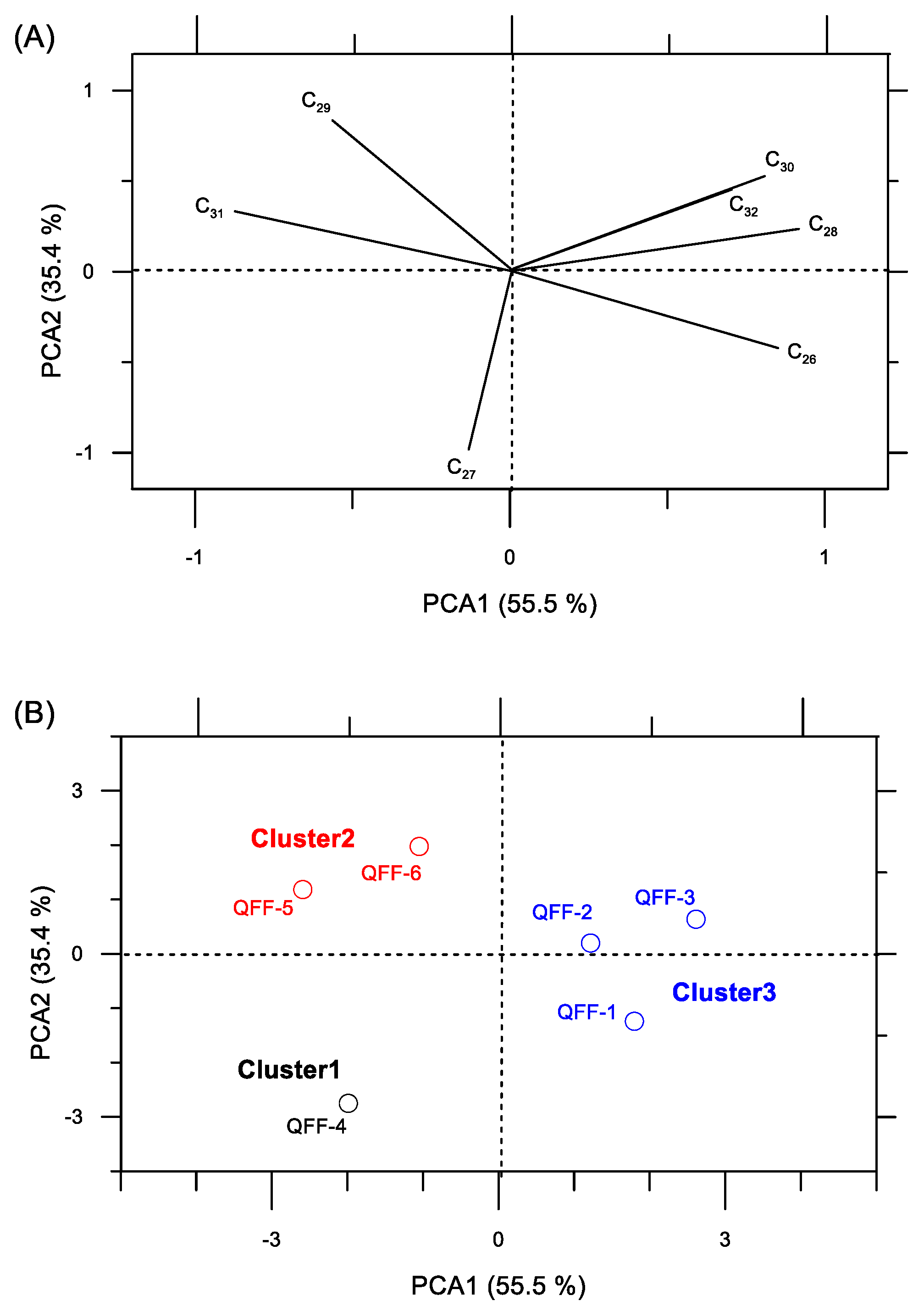Molecular Distributions and Compound-Specific Stable Carbon Isotopic Compositions of Plant Wax n-Alkanes in Marine Aerosols along a North–South Transect in the Arctic–Northwest Pacific Region
Abstract
1. Introduction
2. Experiments
2.1. Aerosol Sample Collection
2.2. Backward Air-Mass Trajectory Analysis
2.3. Analysis of n-Alkanes
2.4. Compound-Specific Stable Carbon Isotope Analysis
2.5. Statistical Analysis
3. Results
4. Discussion
4.1. Anthropogenic Hydrocarbons in Marine Aerosols
4.2. HMW n-Alkanes in Marine Aerosols
5. Conclusions
Author Contributions
Funding
Acknowledgments
Conflicts of Interest
References
- Simoneit, B.R.T. Organic matter of the troposphere: III. Characterization and sources of petroleum and pyrogenic residues in aerosols over the western United States. Atmos. Environ. 1984, 18, 51–67. [Google Scholar] [CrossRef]
- Simoneit, B.R.T. Biomass burning-a review of organic tracers for smoke from incomplete combustion. Appl. Geochem. 2002, 17, 129–162. [Google Scholar] [CrossRef]
- Bush, R.T.; McInerney, F.A. Leaf wax n-alkane distributions in and across modern plants: Implications for paleoecology and chemotaxonomy. Geochim. Cosmochim. Acta 2013, 117, 161–179. [Google Scholar] [CrossRef]
- Eglinton, G.; Hamilton, R.J. Leaf epicuticular waxes. Science 1967, 156, 1322–1335. [Google Scholar] [CrossRef] [PubMed]
- Simoneit, B.R.T.; Chester, R.; Eglinton, G. Biogenic lipids in particulates from the lower atmosphere over the eastern Atlantic. Nature 1977, 267, 682–685. [Google Scholar] [CrossRef]
- Gagosian, R.B.; Peltzer, E.T.; Zafiriou, O.C. Atmospheric transport of continentally derived lipids to the tropical North Pacific. Nature 1981, 291, 312–314. [Google Scholar] [CrossRef]
- Gagosian, R.B.; Peltzer, E.T.; Merrill, J.T. Long-range transport of terrestrially derived lipids in aerosols from the South Pacific. Nature 1987, 325, 800–803. [Google Scholar] [CrossRef]
- Schefuß, E.; Ratmeyer, V.; Stuut, J.-B.W.; Jansen, J.F.; Sinninghe Damsté, J.S. Carbon isotope analyses of n-alkanes in dust from the lower atmosphere over the central eastern Atlantic. Geochim. Cosmochim. Acta 2003, 67, 1757–1767. [Google Scholar] [CrossRef]
- Schreuder, L.T.; Stuut, J.-B.W.; Korte, L.F.; Sinninghe Damsté, J.S.; Schouten, S. Aeolian transport and deposition of plant wax n-alkanes across the tropical North Atlantic Ocean. Org. Geochem. 2018, 115, 113–123. [Google Scholar] [CrossRef]
- Simoneit, B.R.T.; Kobayashi, M.; Mochida, M.; Kawamura, K.; Lee, M.; Lim, H.-J.; Turpin, B.J.; Komazaki, Y. Composition and major sources of organic compounds of aerosol particulate matter sampled during the ACE-Asia campaign. J. Geophys. Res. 2004, 109, D19S10. [Google Scholar] [CrossRef]
- Bendle, J.; Kawamura, K.; Yamazaki, K.; Niwai, T. Latitudinal distribution of terrestrial lipid biomarkers and n-alkane compound-specific stable carbon isotope ratios in the atmosphere over the western Pacific and Southern Ocean. Geochim. Cosmochim. Acta 2007, 71, 5934–5955. [Google Scholar] [CrossRef]
- Fu, P.Q.; Kawamura, K.; Miura, K. Molecular characterization of marine organic aerosols collected during a round-the-world cruise. J. Geophys. Res. 2011, 116, D13302. [Google Scholar] [CrossRef]
- Westerhausen, L.; Poynter, J.; Eglinton, G.; Erlenkeuser, H.; Sarnthein, M. Marine and terrigenous origin of organic matter in modern sediments of the equatorial East Atlantic: The δ13C and molecular record. Deep-Sea Res. I 1993, 40, 1087–1121. [Google Scholar] [CrossRef]
- Huang, Y.; Dupont, L.; Sarnthein, M.; Hayes, J.M.; Eglinton, G. Mapping of C4 plant input from North West Africa into North East Atlantic sediments. Geochim. Cosmochim. Acta 2000, 64, 3505–3513. [Google Scholar] [CrossRef]
- Schefuß, E.; Versteegh, G.J.; Jansen, J.; Sinninghe Damsté, J.S. Lipid biomarkers as major source and preservation indicators in SE Atlantic surface sediments. Deep-Sea Res. I 2004, 51, 1199–1228. [Google Scholar] [CrossRef]
- Ohkouchi, N.; Kawamura, K.; Kawahata, H.; Taira, A. Latitudinal distributions of terrestrial biomarkers in the sediments from the Central Pacific. Geochim. Cosmochim. Acta 1997, 61, 1911–1918. [Google Scholar] [CrossRef]
- Kim, J.-H.; Lee, D.-H.; Yoon, S.-H.; Jeong, K.-S.; Choi, B.; Shin, K.-H. Contribution of petroleum-derived organic carbon to sedimentary organic carbon pool in the eastern Yellow Sea (the northwestern Pacific). Chemosphere 2017, 168, 1389–1399. [Google Scholar] [CrossRef]
- Ohkouchi, N.; Kawamura, K.; Takemoto, N.; Ikehara, M.; Nakatsuka, T. Implications of carbon isotope ratios of C27–C33 alkanes and C37 alkenes for the sources of organic matter in the Southern Ocean surface sediments. Geophys. Res. Lett. 2000, 27, 233–236. [Google Scholar] [CrossRef]
- Bird, M.I.; Summons, R.E.; Gagan, M.K.; Roksandic, Z.; Dowling, L.; Head, J.; Fifield, L.K.; Cresswell, R.G.; Johnson, D.P. Terrestrial vegetation change inferred from n-alkane δ13C analysis in the marine environment. Geochim. Cosmochim. Acta 1995, 59, 2853–2857. [Google Scholar] [CrossRef]
- Madureira, L.A.S.; van Kreveld, S.A.; Eglinton, G.; Conte, M.H.; Ganssen, G.; van Hinte, J.E.; Ottens, J.J. Late Quaternary high-resolution biomarker and other sedimentary climate proxies in a Northeast Atlantic core. Paleoceanography 1997, 12, 255–269. [Google Scholar] [CrossRef]
- Schefuß, E.; Schouten, S.; Jansen, J.H.F.; Sinninghe Damsté, J.S. African vegetation controlled by tropical sea surface temperatures in the mid-Pleistocene period. Nature 2003, 422, 418–421. [Google Scholar] [CrossRef] [PubMed]
- Hughen, K.A.; Eglinton, T.I.; Xu, L.; Makou, M. Abrupt tropical vegetation response to rapid climate changes. Science 2004, 304, 1955–1959. [Google Scholar] [CrossRef] [PubMed]
- Uno, K.T.; Polissar, P.J.; Jackson, K.E.; deMenocal, P.B. Neogene biomarker record of vegetation change in eastern Africa. Proc. Natl. Acad. Sci. USA 2016, 113, 6355–6363. [Google Scholar] [CrossRef] [PubMed]
- Fu, P.Q.; Kawamura, K.; Chen, J.; Charrière, B.; Sempéré, R. Organic molecular composition of marine aerosols over the Arctic Ocean in summer: Contributions of primary emission and secondary aerosol formation. Biogeosciences 2013, 10, 653–667. [Google Scholar] [CrossRef]
- Park, J.; Dall’Osto, M.; Park, K.; Gim, Y.; Kang, H.J.; Jang, E.; Park, K.-T.; Park, M.; Yum, S.S.; Jung, J.; et al. Shipborne observations reveal contrasting Arctic marine, Arctic terrestrial and Pacific marine aerosol properties. Atmos. Chem. Phys. Discuss. 2019. [Google Scholar] [CrossRef]
- Rolph, G.; Stein, A.; Stunder, B. Real-time Environmental Applications and Display sYstem: READY. Environ. Modell. Softw. 2017, 95, 210–228. [Google Scholar] [CrossRef]
- Dall’Osto, M.; Park, J.; Kim, J.-H.; Kang, S.-H.; Park, K.; Bessows, D.C.S.; Harrison, R.M.; Yoon, Y.J. Arctic ship-based evidence of new particle formation events in the Chukchi and East Siberian Seas. Atmos. Environ. 2020, 223, 117232. [Google Scholar] [CrossRef]
- Pang, X.; Pu, J.; Zhao, X.; Ji, Q.; Qu, M.; Cheng, Z. Comparison between AMSR2 sea ice concentration products and pseudo-ship observations of the Arctic and Antarctic sea ice edge on cloud-free days. Remote Sens. 2018, 10, 317. [Google Scholar] [CrossRef]
- Cranwell, P.A.; Eglinton, G.; Robinson, N. Lipids of aquatic organisms as potential contributors to lacustrine sediments–II. Org. Geochem. 1987, 11, 513–527. [Google Scholar] [CrossRef]
- Bray, E.E.; Evans, E.D. Distribution of n-paraffins as a clue to recognition of source beds. Geochim. Cosmochim. Acta 1961, 22, 2–15. [Google Scholar] [CrossRef]
- Simoneit, B.R.T.; Cardoso, J.N.; Robinson, N. An assessment of terrestrial higher molecular weight lipid compounds in aerosol particulate matter over the South Atlantic from about 30–70°S. Chemosphere 1991, 23, 447–465. [Google Scholar] [CrossRef]
- Yadav, S.; Tandon, A.; Attri, A.K. Monthly and seasonal variations in aerosol associated n-alkane profiles in relation to meteorological parameters in New Delhi, India. Aerosol Air Qual. Res. 2013, 13, 287–300. [Google Scholar] [CrossRef]
- R Development Core Team. R: A Language and Environment for Statistical Computing; R Foundation for Statistical Computing: Vienna, Austria, 2015; Available online: http://www.R-project.org (accessed on 17 July 2018).
- Boyer, K.K.; Laitinen, H.A. Automobile exhaust particles: Properties of environmental significance. Environ. Sci. Technol. 1975, 9, 457–459. [Google Scholar] [CrossRef]
- Simoneit, B.R.T.; Mazurek, M.A. Air pollution: The organic components. Crit. Rev. Environ. Control. 1981, 11, 219–276. [Google Scholar] [CrossRef]
- Gough, M.A.; Rowland, S.J. Characterization of unresolved complex mixtures of hydrocarbons in petroleum. Nature 1990, 344, 648–650. [Google Scholar] [CrossRef]
- Kawamura, K.; Ishimura, Y.; Yamazaki, K. Four years observations of terrestrial lipid class compounds in marine aerosols from the western North Pacific. Global Biogeochem. Cycles 2003, 17, 1003. [Google Scholar] [CrossRef]
- Bendle, J.A.; Kawamura, K.; Yamazaki, K. Seasonal changes in stable carbon isotopic composition of n-alkanes in the marine aerosols from the western North Pacific: Implications for the source and atmospheric transport. Geochim. Cosmochim. Acta 2006, 70, 13–26. [Google Scholar] [CrossRef]
- Tao, S.; Yin, X.; Jiao, L.; Zhao, S.; Chen, L. Temporal variability of source-specific solvent-extractable organic compounds in coastal aerosols over Xiamen, China. Atmosphere 2017, 8, 33. [Google Scholar] [CrossRef]
- Fu, P.Q.; Kawamura, K.; Barrie, L.A. Photochemical and other sources of organic compounds in the Canadian high Arctic aerosol pollution during winter-spring. Environ. Sci. Technol. 2009, 43, 286–292. [Google Scholar] [CrossRef]
- Mazurek, M.A.; Simoneit, B.R.T. Characterization of biogenic and petroleum-derived organic matter in aerosols over remote, rural and urban areas. In Identification and Analysis of Organic Pollutants in Air; Keith, L.H., Ed.; Ann Arbor Science/Butterworth: Boston, MA, USA, 1984; pp. 353–370. [Google Scholar]
- Azevedo, D.A.; Moreira, L.S.; Siqueira, D.S. Composition of extractable organic matter in aerosols from urban areas of Rio de Janeiro city, Brazil. Atmos. Environ. 1999, 33, 4987–5001. [Google Scholar] [CrossRef]
- Tang, X.L.; Bi, X.H.; Sheng, G.Y.; Tan, J.H.; Fu, J.M. Seasonal variation of particle size distribution of n-alkanes and polycyclic aromatic hydrocarbons (PAHs) in urban aerosol of Guangzhou, China. Environ. Monit. Assess. 2006, 117, 193–213. [Google Scholar] [CrossRef] [PubMed]
- Tissot, B.P.; Welte, D.H. Petroleum Formation and Occurrence: A New Approach to Oil and Gas Exploration, 2nd ed.; Springer: Berlin, Germany, 1984; pp. 1–702. [Google Scholar] [CrossRef]
- Freeman, K.H.; Hayes, J.M.; Trendel, J.M.; Albrecht, P. Evidence from carbon isotope measurements for diverse origins of sedimentary hydrocarbons. Nature 1990, 343, 254–256. [Google Scholar] [CrossRef] [PubMed]
- Collister, J.W.; Summons, R.E.; Lichtfouse, E.; Hayes, J.M. An isotopic biogeochemical study of the Green River oil shale. Org. Geochem. 1992, 19, 265–276. [Google Scholar] [CrossRef]
- Collister, J.W.; Rieley, G.; Stern, B.; Eglinton, G.; Fry, B. Compound-specific δ13C analyses of leaf lipids from plants with differing carbon dioxide metabolisms. Org. Geochem. 1994, 21, 619–627. [Google Scholar] [CrossRef]
- Huang, Y.; Eglinton, G.; Ineson, P.; Latter, P.M.; Bol, R.; Harkness, D.D. Absence of carbon isotope fractionation of individual n-alkanes in a 23-year field decomposition experiment with Calluna vulgaris. Org. Geochem. 1997, 26, 497–501. [Google Scholar] [CrossRef]
- Lockheart, M.J.; VanBergen, P.F.; Evershed, R.P. Variations in the stable carbon isotope compositions of individual lipids from the leaves of modern angiosperms: Implications for the study of higher land plant-derived sedimentary organic matter. Org. Geochem. 1997, 26, 137–153. [Google Scholar] [CrossRef]
- Chikaraishi, Y.; Naraoka, H. Compound-specific δD–δ13C analyses of n-alkanes extracted from terrestrial and aquatic plants. Phytochemistry 2003, 63, 361–371. [Google Scholar] [CrossRef]
- Chesselet, R.; Fontugne, M.; Buat-Ménard, P.; Ezat, U.; Lambert, C.E. The origin of particulate organic carbon in the marine atmosphere as indicated by its stable carbon isotopic composition. Geophys. Res. Lett. 1981, 8, 345–348. [Google Scholar] [CrossRef]





| Sample No. | Starting Point | End Point | Volume (m3) | ||||||
|---|---|---|---|---|---|---|---|---|---|
| Latitude | Longitude | Date | Time | Latitude | Longitude | Date (yyyy.mm.dd) | Time (UTC) | ||
| (yyyy.mm.dd) | (UTC) | ||||||||
| ARA08 QFF-1 | 70.60 | −139.30 | 2017.09.03 | 16:00 | 69.88 | −139.10 | 2017.09.05 | 15:02 | 2632 |
| ARA08 QFF-2 | 70.50 | −139.00 | 2017.09.07 | 16:18 | 71.00 | −148.50 | 2017.09.13 | 16:12 | 3051 |
| ARA08 QFF-3 | 71.00 | −148.70 | 2017.09.13 | 17:10 | 66.77 | −168.40 | 2017.09.15 | 16:45 | 2755 |
| ARA08 QFF-4 | 55.86 | 170.17 | 2017.09.20 | 20:20 | 49.43 | 158.14 | 2017.09.22 | 20:21 | 2686 |
| ARA08 QFF-5 | 42.88 | 146.19 | 2017.09.24 | 20:59 | 40.16 | 138.14 | 2017.09.26 | 9:30 | 2107 |
| ARA08 QFF-6 | 40.09 | 138.01 | 2017.09.26 | 10:23 | 34.90 | 127.70 | 2017.09.28 | 1:00 | 2267 |
| Sample No. | Geographical Source Sectors for Air-Mass Trajectories | |||
|---|---|---|---|---|
| Pacific Ocean | Arctic Ocean | East Asia | North America | |
| ARA08 QFF-1 | 16.5 | 53.9 | 0 | 29.6 |
| ARA08 QFF-2 | 1.5 | 75.2 | 0 | 23.3 |
| ARA08 QFF-3 | 49.3 | 12.0 | 10.6 | 28.1 |
| ARA08 QFF-4 | 99.7 | 0 | 0.3 | 0 |
| ARA08 QFF-5 | 79.7 | 0.1 | 20.2 | 0 |
| ARA08 QFF-6 | 71.5 | 0 | 28.5 | 0 |
© 2020 by the authors. Licensee MDPI, Basel, Switzerland. This article is an open access article distributed under the terms and conditions of the Creative Commons Attribution (CC BY) license (http://creativecommons.org/licenses/by/4.0/).
Share and Cite
Kim, J.-H.; Park, J.; Kim, S.-B.; Shin, K.-H.; Kim, S.; Gim, Y. Molecular Distributions and Compound-Specific Stable Carbon Isotopic Compositions of Plant Wax n-Alkanes in Marine Aerosols along a North–South Transect in the Arctic–Northwest Pacific Region. Atmosphere 2020, 11, 499. https://doi.org/10.3390/atmos11050499
Kim J-H, Park J, Kim S-B, Shin K-H, Kim S, Gim Y. Molecular Distributions and Compound-Specific Stable Carbon Isotopic Compositions of Plant Wax n-Alkanes in Marine Aerosols along a North–South Transect in the Arctic–Northwest Pacific Region. Atmosphere. 2020; 11(5):499. https://doi.org/10.3390/atmos11050499
Chicago/Turabian StyleKim, Jung-Hyun, Jiyeon Park, Sol-Bin Kim, Kyung-Hoon Shin, Sookwan Kim, and Yeontae Gim. 2020. "Molecular Distributions and Compound-Specific Stable Carbon Isotopic Compositions of Plant Wax n-Alkanes in Marine Aerosols along a North–South Transect in the Arctic–Northwest Pacific Region" Atmosphere 11, no. 5: 499. https://doi.org/10.3390/atmos11050499
APA StyleKim, J.-H., Park, J., Kim, S.-B., Shin, K.-H., Kim, S., & Gim, Y. (2020). Molecular Distributions and Compound-Specific Stable Carbon Isotopic Compositions of Plant Wax n-Alkanes in Marine Aerosols along a North–South Transect in the Arctic–Northwest Pacific Region. Atmosphere, 11(5), 499. https://doi.org/10.3390/atmos11050499





